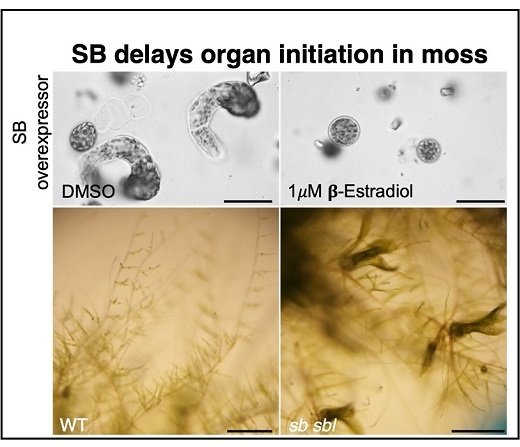
“Sleeping Beauty” is a classic fairy tale written by the Grimm Brothers, depicting the unfortunate princess cursed by a magical fairy to sleep for a hundred years. This timeless bedtime story surely evokes cherished childhood memories for many. However, a recent collaborative research effort between Dr. Ooi-Kock Teh from the Institute of Plant and Microbial Biology at Academia Sinica, and teams from Hokkaido University and Saitama University in Japan, sheds new light on the villain of this fairy tale. The research uncovered two similar arabinogalactan proteins (AGPs) – small proteins harboring a sugar moiety – that yo-yo between a witch and a Beauty.
When highly expressed, these two AGPs seem to cast a profound sleep spell on the moss (Physcomitrium patens), inducing it into a state of dormancy. Due to their significant dormancy effects, the research team has respectively named these two proteins SLEEPING BEAUTY (SB) and SB-like (SBL). Intriguingly, protein sequences of SB and SBL do not resemble any other proteins in plants, adding complexity to predicting their functions and understanding why they can trigger the cessation of cell growth on the cell surface.
AGPs are highly glycosylated proteins found in the plant cell wall. The name of these proteins is derived from their structure, which includes monosaccharides such as arabinose and galactose. They are believed to play a crucial role in plant signaling and act as regulators in various developmental processes. The team observed that mutant strains of Physcomitrium patens lacking SB and SBL, compared to wild-type strains with functional SB and SBL, generated their leaf-like gametophore structures a few days earlier. In moss plants, gametophores play a pivotal role in reproduction.

The accelerated formation of gametophores in the SB double mutant led the team to postulate that SBs may be involved in cell wall loosening, a process that is critical for growth and, in this case, organ initiation. Unlike animal cells, plant cells are encased in walls that need to be loosened before protrusion and expansion can take place. To confirm this hypothesis, the team examined the sugar composition of the cell wall in the SB mutants. Since the cell wall is primarily composed of polysaccharides such as cellulose, hemicellulose, and pectin, any changes in the structure of cells will be reflected in their sugar compositions. Predictably, cell walls in the SB mutant appeared to be specifically reduced in galactose monosaccharides, an indication that the pectin matrix of the wall is altered.
Based on a series of genetic, cell biology, and biochemistry analyses, researchers discovered that the abundance of SB proteins on the cell surface is positively correlated with the activity of a transcription factor in the cell. This transcription factor – designated ARFC2 – acts in response to the presence of the plant growth hormone auxin, and restricts the expression of a suite of cell wall-localized pectin methylesterases that specifically modify pectins. It appears that SB on the cell surface communicates with ARFC2 to control how much pectin methylesterases are made. This in turn modulates cell wall stiffening, which is crucial to generate new organs and, thus, for plant morphogenesis.
“For years it was never quite clear to plant biologists what arabinogalactan proteins are doing in the cell wall. Our findings provide clues on the mechanistic action of arabinogalactan proteins, and demonstrate how they can contribute to cell wall remodeling”, explains Dr. Teh. “Our next step is to understand how SB communicates with ARFC2 in the cell, and whether sugar moieties play a role in SB function. These are exciting questions that, if answered, will contribute significantly to the field of cell wall biology.”
One tends to picture Sleeping Beauty as a weak and vulnerable character who falls victim to the villainous act of a bewitched fairy. It’s time to shift our mindset and think of Sleeping Beauty as an empowered heroine who is capable of taking control and making things happen the way she wants, at least in the plant world. While the fairy tale of Sleeping Beauty will continue to enchant children in years to come, the eponymous arabinogalactan protein is likely to be an open sesame for more exciting discoveries.
【Extended Reading】
Ooi Kock Teh*, Prerna Singh, Junling Ren, Lin Tzu Huang, Menaka Ariyarathne, Benjamin Prethiviraj Salamon, Yu Wang, Toshihisa Kotake, Tomomichi Fujita*
Surface-localized glycoproteins act through class C ARFs to fine-tune gametophore initiation in Physcomitrium patens
Development (2022) 149 (24): dev200370.
https://journals.biologists.com/dev/article/149/24/dev200370/282110/Surface-localized-glycoproteins-act-through-class
